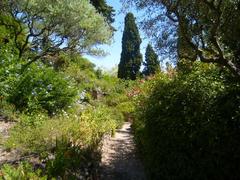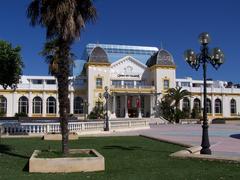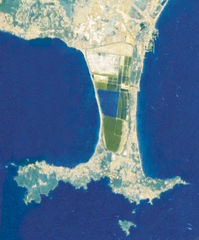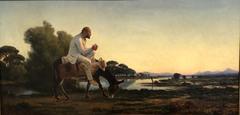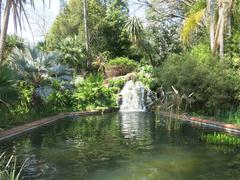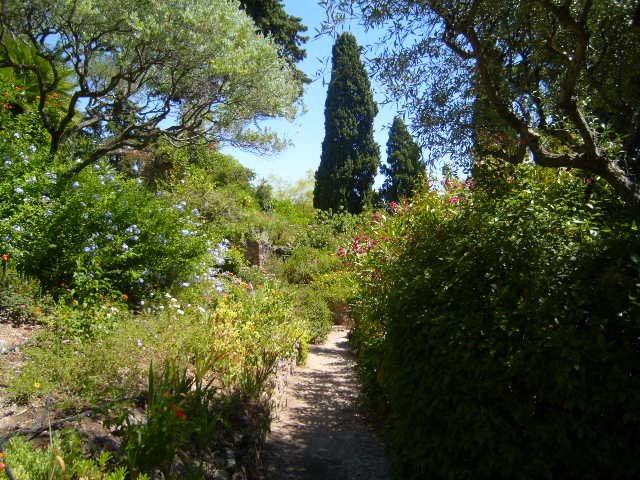
Visiting Castel Sainte-Claire: Hours, Tickets, and Travel Tips
Date: 31/07/2024
Introduction
Nestled in the picturesque town of Hyères, France, Castel Sainte-Claire stands as a testament to the region’s rich historical and cultural tapestry. This magnificent villa, perched on the heights above the old town, is not only a beacon of architectural splendor but also a botanical treasure trove, thanks to the efforts of its various notable residents. From its origins in the 19th century under the stewardship of Colonel Olivier Voutier, the discoverer of the Venus de Milo, to its transformation by the renowned American author Edith Wharton, Castel Sainte-Claire has continually evolved, both in structure and significance (HouseHistree) (Independent).
Wharton’s influence, particularly in the garden’s design, has left an indelible mark, creating a space that boasts a variety of exotic plants and flowers, ensuring year-round beauty. Today, the villa and its gardens are maintained by the city of Hyères and remain open to the public, offering a serene escape for visitors and a glimpse into the past. Whether you are a history enthusiast, a gardening aficionado, or simply someone seeking tranquility, Castel Sainte-Claire promises a captivating experience (HouseHistree).
Table of Contents
- Introduction
- Origins and Early History
- Edith Wharton’s Influence
- Architectural Evolution
- Later Years and Preservation
- Visitor Information
- Travel Tips
- Nearby Attractions
- Special Events
- Guided Tours and Photographic Spots
- Notable Residents
- Architectural and Horticultural Highlights
- Preservation Efforts
- FAQ Section
- Conclusion
Origins and Early History
Castel Sainte-Claire, located in Hyères, France, has a rich and varied history that dates back to the 19th century. The property was initially developed by Colonel Olivier Voutier, a notable figure in French naval history and the discoverer of the famous statue, the Venus de Milo. Voutier purchased the land in 1830 and constructed the original house, which he named after his wife, Palmire d’Alpuget Voutier. The couple resided there until their deaths in the late 19th century (HouseHistree).
Edith Wharton’s Influence
In the early 20th century, the property was acquired by the American author Edith Wharton, best known for her Pulitzer Prize-winning novel, “The Age of Innocence.” Wharton purchased Castel Sainte-Claire in 1927 and made significant modifications to both the house and its gardens. Her influence is still evident today, particularly in the garden’s design, which features a variety of exotic plants and flowers that were chosen to ensure year-round beauty (Independent).
Architectural Evolution
The architecture of Castel Sainte-Claire has evolved significantly over the years. The original structure built by Voutier was relatively modest, but Wharton expanded it to include more living space and modern amenities. The house is a blend of traditional Provencal architecture and early 20th-century modernist influences, making it a unique landmark in Hyères. The gardens, designed by Wharton, feature terraces planted with cactus, agave, magnolias, and a large araucaria tree, reflecting her keen interest in horticulture (Independent).
Later Years and Preservation
After Wharton’s death in 1937, the property changed hands several times but has remained a significant cultural and historical site. It is now owned by the city of Hyères and is open to the public. The gardens, in particular, are a major attraction, drawing visitors from around the world who come to admire the diverse plant species and the stunning views of the Mediterranean Sea (HouseHistree).
Visitor Information
Visiting Hours
Castel Sainte-Claire is open to visitors daily from 10 AM to 6 PM.
Tickets
Admission to the gardens is free, but guided tours of the house require a ticket, which can be purchased on-site or online.
Accessibility
The gardens are wheelchair accessible, and there are facilities available for visitors with disabilities.
Travel Tips
Best Time to Visit
The best time to visit Castel Sainte-Claire is during the spring and summer months when the gardens are in full bloom.
How to Get There
Castel Sainte-Claire is easily accessible by car or public transportation. It is located just a short drive from the center of Hyères.
Nearby Attractions
While in Hyères, be sure to explore other historical sites such as the Old Town, Villa Noailles, and the Parc St. Bernard. Each offers its own unique charm and historical significance.
Special Events
Throughout the year, Castel Sainte-Claire hosts a variety of events, including art exhibitions, literary gatherings, and garden tours. Check the official website for a calendar of upcoming events.
Guided Tours and Photographic Spots
Guided tours of Castel Sainte-Claire provide an in-depth look at the property’s history and its famous residents. Don’t forget to bring your camera, as there are plenty of picturesque spots, especially in the gardens.
Notable Residents
Olivier Voutier
Colonel Olivier Voutier, the original owner, was a distinguished naval officer and archaeologist. His discovery of the Venus de Milo in 1820 brought him international fame. Voutier’s contributions to the field of archaeology and his adventurous spirit are commemorated at Castel Sainte-Claire, where he spent his later years (HouseHistree).
Edith Wharton
Edith Wharton, one of America’s most celebrated authors, made Castel Sainte-Claire her home in the late 1920s. Her influence on the property is profound, particularly in the design of the gardens. Wharton’s love for gardening and her architectural vision transformed the estate into a picturesque retreat that continues to captivate visitors today (Independent).
Elisina Tyler
Elisina Tyler, another notable resident, was a prominent socialite and patron of the arts. Her tenure at Castel Sainte-Claire further enriched the property’s cultural heritage. Tyler was known for hosting literary and artistic gatherings, making the estate a vibrant center of cultural activity in the early 20th century (HouseHistree).
Architectural and Horticultural Highlights
The architecture of Castel Sainte-Claire is a blend of traditional and modern elements. The house features classic Provencal design with modernist touches added by Wharton. The gardens are a highlight, featuring a variety of exotic plants that were carefully selected to thrive in the Mediterranean climate. The upper terraces are dominated by cactus and agave, while the lower levels feature magnolias and other flowering plants (Independent).
Preservation Efforts
The city of Hyères has made significant efforts to preserve Castel Sainte-Claire and its gardens. The property is maintained by the local government and is open to the public, ensuring that its historical and cultural significance is preserved for future generations. Various restoration projects have been undertaken to maintain the house and gardens in their original condition, allowing visitors to experience the estate as it was during the time of its famous residents (HouseHistree).
FAQ Section
- What are the opening hours of Castel Sainte-Claire? Castel Sainte-Claire is open daily from 10 AM to 6 PM.
- How much are the tickets for Castel Sainte-Claire? Admission to the gardens is free, but guided tours of the house require a ticket.
- Is Castel Sainte-Claire wheelchair accessible? Yes, the gardens are wheelchair accessible.
- Can I take photos at Castel Sainte-Claire? Yes, photography is allowed, especially in the gardens where there are many picturesque spots.
Conclusion
Castel Sainte-Claire is a historical and cultural gem in Hyères, France. Its rich history, architectural beauty, and stunning gardens make it a must-visit destination for anyone interested in the region’s heritage. The legacy of its notable residents, including Olivier Voutier, Edith Wharton, and Elisina Tyler, continues to attract visitors from around the world, ensuring that Castel Sainte-Claire remains a vibrant part of Hyères’ cultural landscape. Don’t miss your chance to explore this remarkable site and immerse yourself in its fascinating history. For more information, visit the official website.
Call to Action
Planning a visit to Hyères? Download our mobile app Audiala for more insights and travel tips. Follow us on social media for updates on the latest events and attractions!
References
- HouseHistree. (n.d.). Castel Sainte-Claire. Retrieved from HouseHistree.
- Independent. (2023). Hyères, France: A forgotten gem that still has a sparkle. Retrieved from Independent.
- Wikipedia. (n.d.). Castel Sainte-Claire. Retrieved from Wikipedia.
- Hyères Tourism. (n.d.). Official website. Retrieved from Hyères Tourism.
